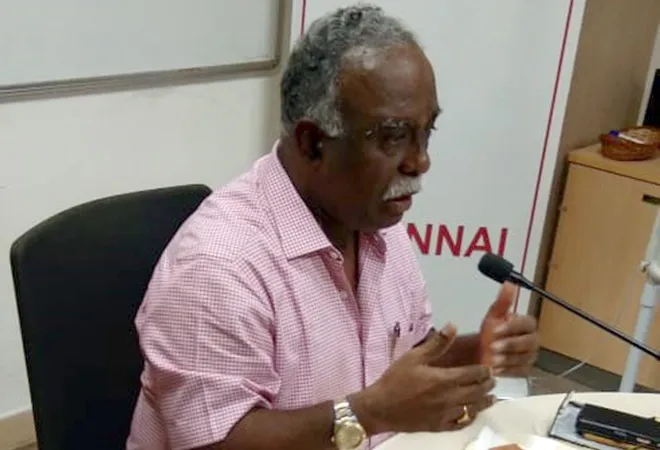-
CENTRES
Progammes & Centres
Location
There needs to be a technology acquisition drive to military modernisation plans.

Air Marshal M. Matheswaran (retd) has emphasised on the immediate need for India to modernise its defence forces, pointing out that technological deficiencies had resulted in advanced Pakistani fighter jets penetrating the Indian airspace after the Balakot strike.
“The use of air power at Balakot marked a major paradigm-change in the way India has responded to cross-border terror-attacks on its soil,” said Air Marshal M. Matheswaran (retd), chairman and president, The Peninsula Foundation, Chennai.
Initiating a discussion on “Pulwama mood and post-poll security concerns” at Observer Research Foundation, Chennai, on 15 June 2019, Air Marshal Matheswaran, spoke about how the Balakot operation allowed India to call Pakistan’s nuclear bluff and execute an operation on their soil without escalating the conflict beyond the nuclear threshold.
“The use of air power at Balakot marked a major paradigm-change in the way India has responded to cross-border terror-attacks on its soil,” he said.
The talk, which covered in depth how the Balakot operation, launched post-Pulwama terror-attack, altered the rules of engagement, also covered how the PAF has evolved into an air force matching with India’s on the technology front. Air Marshal Matheswaran spoke at length about the relative weakness of the IAF on the electronic warfare front and how the Pakistani use of F-16 Block 52 in the retaliatory strike had kept the frontline fighters of the IAF at bay.
Air Marshal Matheswaran opined that this chink in the IAF’s armour had resulted in the inability of offering escorts to the MiG-21 piloted by Wing Commander Abhinandan Varthaman and led to it being shot down. He also expressed disappointment on how the downing of a Mi-17 helicopter of the IAF by a ‘friendly fire’ could have been avoided. The helicopter was reported to have been shot down over the Budgam sector by an Indian missile as its ‘Identify, Friend or Foe’ (IFF) transponders were not switched on before the mission.
Speaking about the lead up to the Balakot air-strike, Air Marshal Matheswaran detailed how the IAF had relied on the state-of-the-art technology to execute a deep strike with great precision. He was appreciative of the use of SPICE bomb kits in the air-strike, as he believed it provided the IAF the luxury of deploying it from distant, stand-off ranges. However, he was also critical of the fact that the Indian Air Force lacked force-multipliers as there were only three Airborne Warning and Control System (AWACS) aircraft as against the requirement of at least eight such systems for a country of the size of India. This, he believed, gave the PAF a window of opportunity to enter the Indian air space.
Additionally, he also observed that the PAF was no longer a push-over and that the technological gap between the IAF and the PAF had shrunk in the wake of the latter’s adoption of Block 52, a modern variant of the US F-16 Fighting Falcon. He also noted that the JF-17s, Pakistan’s indigenous fighter built in collaboration with China, was a capable platform that allowed the PAF to field it in numbers. The JF-17 also benefited from China’s continual work on the platform’s electronic warfare capabilities.
Delving into the response of the international community on the Balakot strike, Air Marshal Matheswaran pointed out that India’s rise as an economic power in the region had largely influenced how the response played out. He noted that India, a country with great track-record in anti-terrorism, had the support of the West and had also managed to get Pakistan grey-listed on the FATF and APG. This, he believed, would go a long way in cutting off funds for the terror infrastructure in Pakistan.
While being appreciative of the IAF during the Balakot operation, Air Marshal Matheswaran also pointed out the immediate need for the modernisation of the armed forces that was needed more now than earlier. Remarking that the 21st century world order is about technology dominance, he emphasised that India needed to be realistic in its approach towards being a great power and needed to allocate resources towards reaching the goal by overhauling its defence infrastructure and procurement policies.
Pointing at the aging fleet of the IAF, Air Marshal Matheswaran regretted that the modernisation of the IAF had become a dilemma of resource constraints. With the result and even otherwise, procurements were piecemeal, leading to loss of leverage during future acquisitions. He was also critical of the fact that the IAF is operating well below its sanctioned squadron strength of 42, and the number is likely to dip below 30 soon. This, compared with the PAF, which operates 28 squadrons, would be insufficient, when considering the two-front wars for India, including China.
In conclusion, Air Marshal Matheswaran said that the National Security Policy needed to be comprehensive and there needs to be a necessary technology acquisition to drive military modernisation plans. He also remarked that the defence budget, which currently hovered around 1.5% of the GDP, was insufficient to protect and promote India’s national interests and needed to be elevated above 2.5%, as it was critical to the national economy as well.
This report was prepared by Gururag Kalanidhi, Research Associate, Observer Research Foundation, Chennai.
The views expressed above belong to the author(s). ORF research and analyses now available on Telegram! Click here to access our curated content — blogs, longforms and interviews.